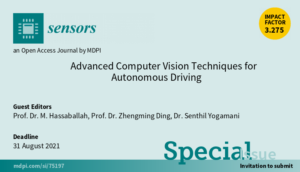Autonomous driving (AD) refers to self-driving vehicles or any transport system moves without humans. Automotive systems are equipped with cameras and sensors to cover all the fields of view and range. Further, sensor architecture in AD includes multiple sets of cameras, radars, and LIDARs, as well as GPS-GNSS for absolute localization and inertial measurement units that provide a 3D pose of the vehicle in space. Representation of the environment state or scene understanding is utilized by a decision-making system to produce the final driving policy, which can be achieved by a combination of several perception or computer vision tasks such as semantic segmentation, motion estimation, depth estimation, and soiling detection. Computer vision is as a key technique in AD technologies. Thus, there is a need to explore new and emerging trends in computer vision for autonomous driving. This Special Issue aims to address the most up-to-date impacts of computer vision on progress autonomous driving research. Topics of interest include but are not limited to:
- New trends on vision and sensors for autonomous driving;
- Vision‐based traffic flow analysis and smart vehicle technologies;
- Vehicle trajectory prediction in autonomous driving;
- Vehicle classification and semantic segmentation;
- Traffic sign detection, recognition, and scene understanding;
- Detection, tracking, learning, and predicting on-road pedestrian behavior;
- Object detection and tracking on Fisheye cameras for autonomous driving;
- Unsupervised, weakly-supervised, and reinforcement deep.
https://www.mdpi.com/journal/sensors/special_issues/driving_computer_vision
Prof. Dr. M. Hassaballah
Prof. Dr. Zhengming Ding
Dr. Senthil Yogamani




 March 16th, 2021
March 16th, 2021  Daniela Lopez de Luise
Daniela Lopez de Luise 
 Posted in
Posted in